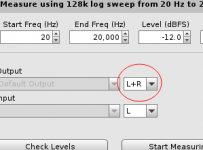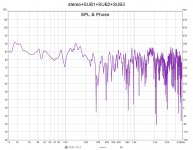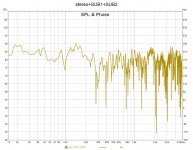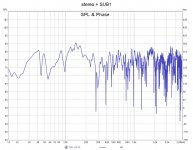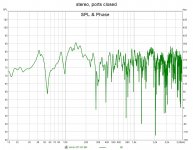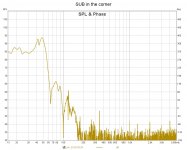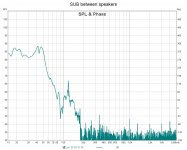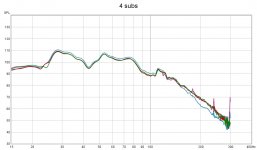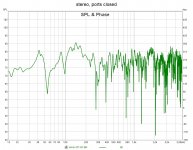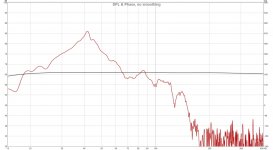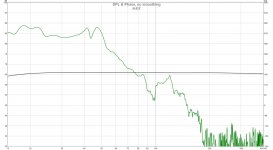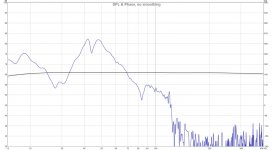Ah, sorry, I meant LP filter, of course.Beige,
All my subs are sealed. The only sub that has a high pass filter is my 21 inch to minimize excessive excursion below 20 Hz. All of the subs have low pass filters, all are at different frequencies and slopes vary between 2nd to 4th order (Linkwitz-Riley) and phase is different for all of them too.
It’s what works and measures best depending on sub location and design.
Would you care to explain more how and why did you choose LP frequencies and slopes?
Ah, sorry, I meant LP filter, of course.
Would you care to explain more how and why did you choose LP frequencies and slopes?
Without getting into too much detail, I primarily used Method B stated in this link:
Tuning multiple subs
The most important advice I can give you is that after adding the second sub, if the FR does not look substantially flatter then move that second sub to another location and repeat the measurement or move the 1st sub and repeat the measurement. Also, don’t use smoothing (to maximize resolution) and only look at frequencies below 300Hz. I smooth after all 4 subs are integrated to my satisfaction preferably with as little EQ as possible, and hopefully lower order LP filters (which isn’t always possible). But first I always move the subs around as much as I can. Having a dedicated room helps but not everyone does. Still there are plenty that have done this in their family room.
Yes, it takes time and effort. Having a colleague or colleagues to help move the subs can be quite beneficial.
Best,
Anand.
Is that even possible without manually achieving this by removing one cable and add an Y splitter?For the purposes of setting up the subs, play the same signal through both L+R mains and treat as a single source, not two.
I don't see REW offering such option.
Thank you, Anand!Without getting into too much detail, I primarily used Method B stated in this link:
Tuning multiple subs
The most important advice I can give you is that after adding the second sub, if the FR does not look substantially flatter then move that second sub to another location and repeat the measurement or move the 1st sub and repeat the measurement. Also, don’t use smoothing (to maximize resolution) and only look at frequencies below 300Hz. I smooth after all 4 subs are integrated to my satisfaction preferably with as little EQ as possible, and hopefully lower order LP filters (which isn’t always possible). But first I always move the subs around as much as I can. Having a dedicated room helps but not everyone does. Still there are plenty that have done this in their family room.
Yes, it takes time and effort. Having a colleague or colleagues to help move the subs can be quite beneficial.
You mean smoothing the graphs isn't helpful? Below 500 Hz I usually don't use it. When looking at full range 1/24 smoothing improves graph visibility.
Beige,
Smoothing the graphs reduces resolution such that you cannot see the problematic areas that may need to be addressed (peaks and dips in the FR curve). This is my opinion of course, others may strongly disagree. For that purpose, below the Schroeder frequency when I am setting up a multisub setup, I do not use smoothing. After doing my best to implement the multisub setup, as a final visual, I use some smoothing, like 1/12th octave.
It was my understanding that the REW generator outputs the same signal to the Left and Right channels, so essentially you have a mono signal (I remember it was even a feature you could engage). I don’t think Earl uses REW so he may be unfamiliar with it.
Best,
Anand.
Smoothing the graphs reduces resolution such that you cannot see the problematic areas that may need to be addressed (peaks and dips in the FR curve). This is my opinion of course, others may strongly disagree. For that purpose, below the Schroeder frequency when I am setting up a multisub setup, I do not use smoothing. After doing my best to implement the multisub setup, as a final visual, I use some smoothing, like 1/12th octave.
It was my understanding that the REW generator outputs the same signal to the Left and Right channels, so essentially you have a mono signal (I remember it was even a feature you could engage). I don’t think Earl uses REW so he may be unfamiliar with it.
Best,
Anand.
The MinDSP write-up is very good. My opinion is that virtually all of these methods produce vastly better results than not using multiple subs as clearly shown by the data. Any of them are going to sound much better and may even be indistinguishable from each other because they are all so good.
Me? I didn't have much choice in locations, so I never moved subs around. And I am lazy, so I just did the simplest and cheapest way to achieve my results. In the end all that matters is the results. Clearly the more time spent the better the results will be, but at some point all the extra work won't really make that much difference.
The key here is to use multiple subs spread around the room. You simply cannot get as good of results as shown without them. EQ is a big help and technique matters to some degree, but it's the use of multiple subs that really makes the difference.
And yes, I do use a Y connector in my measurements.
Me? I didn't have much choice in locations, so I never moved subs around. And I am lazy, so I just did the simplest and cheapest way to achieve my results. In the end all that matters is the results. Clearly the more time spent the better the results will be, but at some point all the extra work won't really make that much difference.
The key here is to use multiple subs spread around the room. You simply cannot get as good of results as shown without them. EQ is a big help and technique matters to some degree, but it's the use of multiple subs that really makes the difference.
And yes, I do use a Y connector in my measurements.
It can.that the REW generator outputs the same signal to the Left and Right channels,
Attachments
Thank you guys, you're really great and I do appreciate your help!
Yes, Anand is right, REW signal is mono so mains are treated as mono source.
Now I'm good to go. I was building some additional treatment and I wanted to wait until it's done. That's why I was asking all those questions and did no "field testing".
Yes, Anand is right, REW signal is mono so mains are treated as mono source.
Now I'm good to go. I was building some additional treatment and I wanted to wait until it's done. That's why I was asking all those questions and did no "field testing".
Okay, I finally started.
Of course, there is a question. Again.
I know corner placement is preffered but I did a measurement in the corner and near the corner (between main speakers). I don't see any significant difference. What bothered me is how the gain is dropping above the 50 Hz area. What do you guys think?

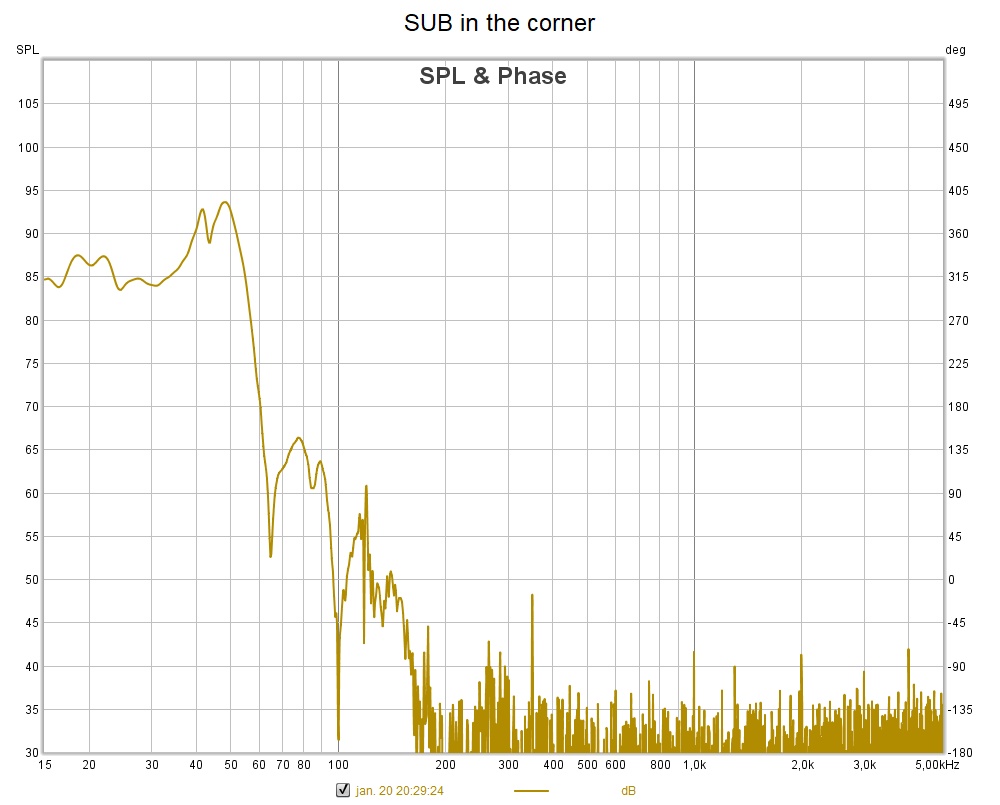
I then proceeded with adding subs. No EQ and no listening test as I have one more sub to add. Subs 1 and 2 are between main speakers, sub 3 is behind listening position.
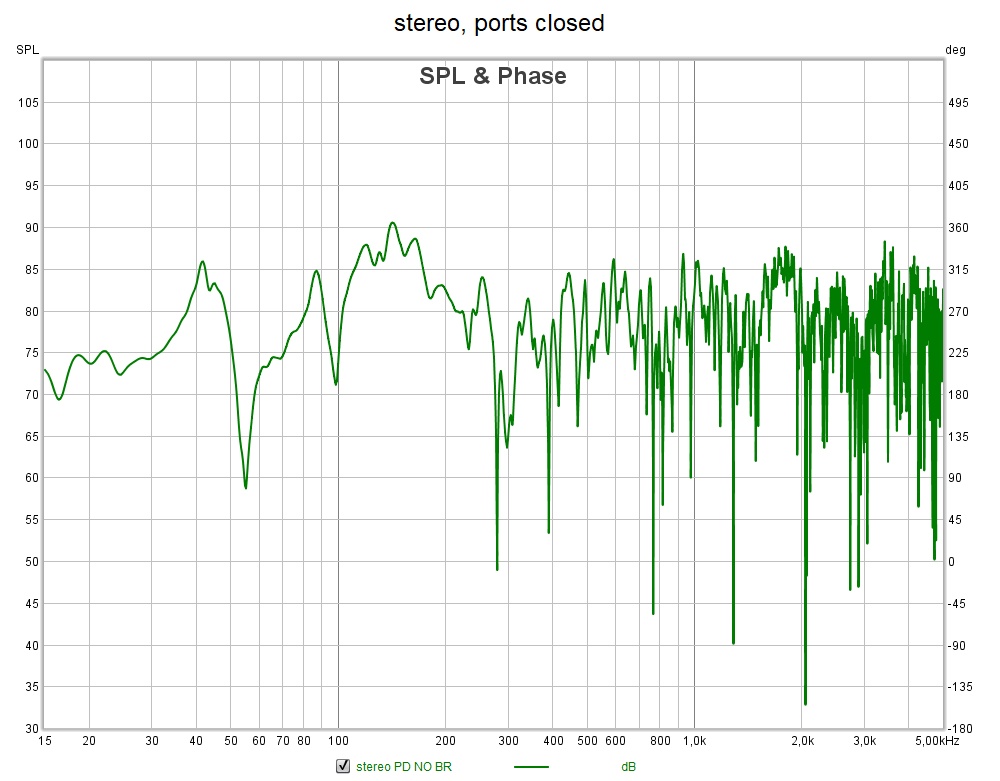
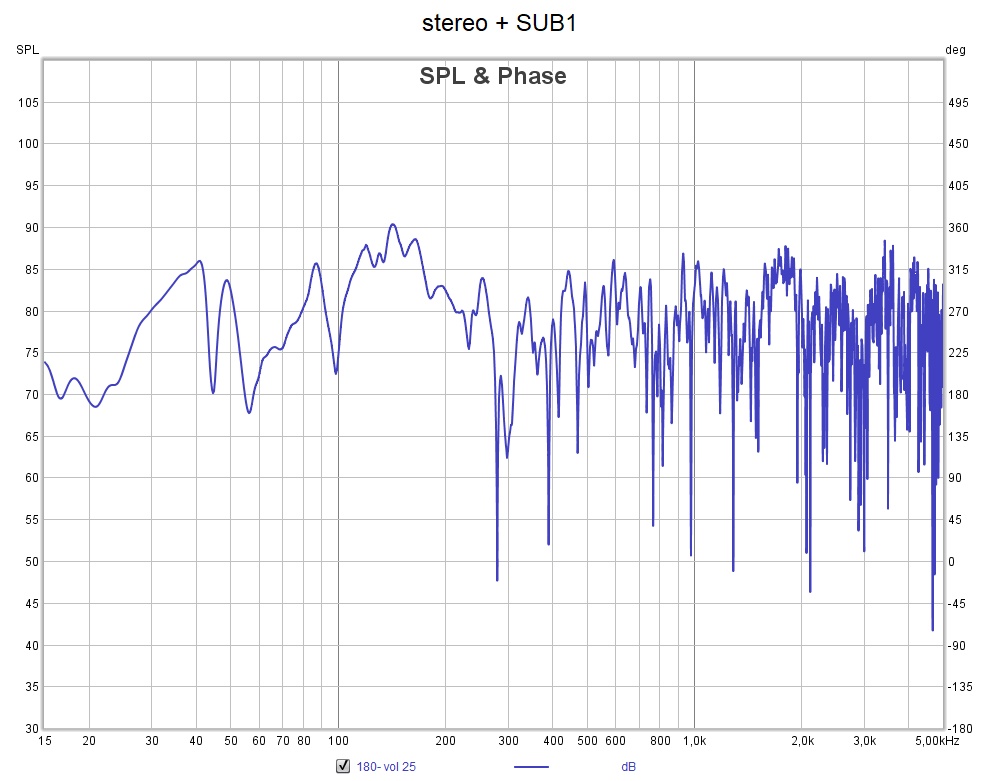


Of course, there is a question. Again.
I know corner placement is preffered but I did a measurement in the corner and near the corner (between main speakers). I don't see any significant difference. What bothered me is how the gain is dropping above the 50 Hz area. What do you guys think?
I then proceeded with adding subs. No EQ and no listening test as I have one more sub to add. Subs 1 and 2 are between main speakers, sub 3 is behind listening position.
Attachments
I would do things differently. I would show four curves on a single plot; mains, sub1, sub2, sub3, not sumed, but each separate. That will tell you which subs should be dominant and which added later, if required.
Your sub 1 for example is not satisfactory as it obviously has some internal LP filter. It may be a great sub for the last sub added, but certainly not the first. The first should have a lot of overlap with the mains. To me, it is obvious that none of your subs is adequately dealing with the mains issue at about 100 Hz, which means that none of them appear to be going high enough in frequency to affect this region. The "modal" nature of the room is quite evident in your curves as the Schroeder Frequency (Fs) is clearly at just over 200 Hz. The subs need to go almost up to Fs. This must be a fairly small room with little LF absorption.
That said, it is obvious that the multiple sub situation is the best of them all, actually down right decent. Just goes to prove my point: it's multiple subs that matter, not so much the EQ or the technique, both of which will just be "icing on the cake."
Your sub 1 for example is not satisfactory as it obviously has some internal LP filter. It may be a great sub for the last sub added, but certainly not the first. The first should have a lot of overlap with the mains. To me, it is obvious that none of your subs is adequately dealing with the mains issue at about 100 Hz, which means that none of them appear to be going high enough in frequency to affect this region. The "modal" nature of the room is quite evident in your curves as the Schroeder Frequency (Fs) is clearly at just over 200 Hz. The subs need to go almost up to Fs. This must be a fairly small room with little LF absorption.
That said, it is obvious that the multiple sub situation is the best of them all, actually down right decent. Just goes to prove my point: it's multiple subs that matter, not so much the EQ or the technique, both of which will just be "icing on the cake."
Hi Earl,
thanks for your comments!
I can provide single plots, no problem! I'm just about to do some more testing.
Yes, room is small, approx 70m3 with mostly 8" damping.
No filters are activated on the subs, I re-checked the settings again.
First two plots (one in the corner and other near mains) are from SUB2.
Please, see here, I measured each sub (I have 4 equal subs). I didn't place the mic close enough to the cone so probably room is affecting the measurements. Am I seeing this right - that 45 and 100 Hz are room modes?
Not sure what can I do to deal with 100 Hz issue. Elevate the subs?
Seems like you had similar situation here:
Multiple Subwoofer after Geddes
What did you do here at 100 Hz?
thanks for your comments!
I can provide single plots, no problem! I'm just about to do some more testing.
Yes, room is small, approx 70m3 with mostly 8" damping.
No filters are activated on the subs, I re-checked the settings again.
First two plots (one in the corner and other near mains) are from SUB2.
Please, see here, I measured each sub (I have 4 equal subs). I didn't place the mic close enough to the cone so probably room is affecting the measurements. Am I seeing this right - that 45 and 100 Hz are room modes?
Not sure what can I do to deal with 100 Hz issue. Elevate the subs?
Seems like you had similar situation here:
Multiple Subwoofer after Geddes
What did you do here at 100 Hz?
Attachments
The mic should be at the listeners position, not near field. The measurements have to contain the room. That's what we are trying to tame.
So those are the four subs? Where is the sharp 50 Hz. LP seen in the previous plots?
I'd say modes are at 30, 55 and 75 Hz, from what I see.
So those are the four subs? Where is the sharp 50 Hz. LP seen in the previous plots?
I'd say modes are at 30, 55 and 75 Hz, from what I see.
No, no. These 4 subs were measured just for testing purposes. To see if they all output the same signal. That's why I took nearfield measurements.
The 6 plots on previous page were taken with mic on listening position.
And here are plots for each sub - mic of course on seating position.
EDIT2: you are right, there was a HP filter. I didn't see it. Sub1 now has similar curve as Sub2. Thank you, Earl, I'm thankful you saw that. That's mileage, which I don't have.
The 6 plots on previous page were taken with mic on listening position.
And here are plots for each sub - mic of course on seating position.
EDIT2: you are right, there was a HP filter. I didn't see it. Sub1 now has similar curve as Sub2. Thank you, Earl, I'm thankful you saw that. That's mileage, which I don't have.
Attachments
Last edited:
Beige
Personally I would want at least one of my subs to go above 100 Hz to better overlap the mains and help the mains issue at 100 Hz.
I am unclear how a sub cannot have much above 80 Hz as you show, is it a bandpass design? This is why I prefer just a simple closed box with a big driver. I can EQ this to be whatever I need it to be even up to 200 Hz + if I want. I gave up on bandpass and ported years ago.
Personally I would want at least one of my subs to go above 100 Hz to better overlap the mains and help the mains issue at 100 Hz.
I am unclear how a sub cannot have much above 80 Hz as you show, is it a bandpass design? This is why I prefer just a simple closed box with a big driver. I can EQ this to be whatever I need it to be even up to 200 Hz + if I want. I gave up on bandpass and ported years ago.
To me it looks like the room is sucking up 45 and 100 Hz tones. Subs are closed design, declarated from 15-120 Hz (+/- 3dB)
Here's a test:
Velodyne DD-15+ Measurements & Analysis | Audioholics
(Mine are without +)
I have to try elevating the subs, perhaps it would make a difference.
Here's a test:
Velodyne DD-15+ Measurements & Analysis | Audioholics
(Mine are without +)
I have to try elevating the subs, perhaps it would make a difference.
This is precisely why I would not use subs with internal electronics. Those curves show a huge dependence of FR on level and this will pose serious problems with what you are trying to do. They also show a very limited output response above about 80 Hz - not what you want. I'd use different subs.
What do you mean by limited output response? They are flat from 50-100 Hz.
I was hoping this would not be a problem.
If this was one of your examples - Multiple Subwoofer after Geddes - how did you cope with 105 Hz and above?
I was hoping this would not be a problem.
If this was one of your examples - Multiple Subwoofer after Geddes - how did you cope with 105 Hz and above?
- Home
- Loudspeakers
- Subwoofers
- Multiple Small Subs - Geddes Approach
